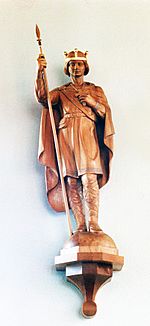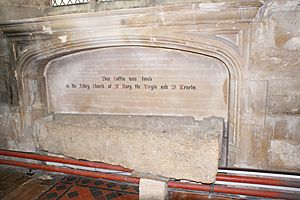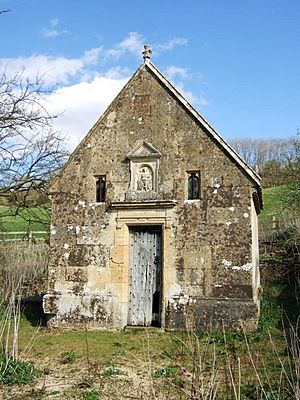Saint Kenelm facts for kids
Quick facts for kids Saint Kenelm |
|
|---|---|
 |
|
| Born | c. 786 |
| Died | 17 July 821 Clent Hills |
| Venerated in | Catholic Church Eastern Orthodox Church |
| Canonized | Pre-Congregation |
| Major shrine | Winchcombe Abbey |
| Feast | 17 July |
Saint Kenelm (also known as Cynehelm) was a famous Anglo-Saxon saint in medieval England. Many people traveled to Winchcombe on his feast day to honor him. His story is even mentioned in the famous book Canterbury Tales.
According to legend, Saint Kenelm was a young prince from the royal family of Mercia. He became king when he was just a boy. Sadly, he was murdered by a jealous relative. But his body was found through a miracle. It was then taken to a special shrine at Winchcombe Abbey, where it stayed for hundreds of years.
Two places are very important to Kenelm's story. The Clent Hills, near Birmingham, England, are said to be where he was murdered. The town of Winchcombe, in Gloucestershire, is where his body was buried. Today, a small church named after St Kenelm stands in the Clent Hills. For many years, people in the village of Romsley celebrated St Kenelm's Day on July 17th. They had a fair and a fun tradition called "crabbing the parson," where they threw crab apples at the local priest!
Contents
The Amazing Story of Saint Kenelm
The Winchcombe Abbey Version

The oldest written version of St Kenelm's story comes from a book at Winchcombe Abbey from the 1100s. It says that a monk from Worcester named Wilfin first told the tale.
Here is the story: Around the year 819 or 821, King Coenwulf of Mercia died. He left behind two daughters, Quendryda and Burgenhilda, and a seven-year-old son named Kenelm. Young Kenelm was chosen to be the next king.
However, his sister Quendryda was very jealous. She wanted to be queen herself. So, she made a plan with her lover, Askobert, who was also Kenelm's teacher. She gave Askobert money and told him to kill her brother so she could rule. The chance came during a hunting trip in the forests of Worcestershire.
The night before the hunt, Kenelm had a strange dream. He dreamed he climbed a tall tree covered in flowers and lights. From the top, he could see all parts of his kingdom. Three parts bowed to him, but the fourth part started chopping down the tree. When the tree fell, Kenelm turned into a white bird and flew away to safety.
When he woke up, the young king told his dream to his nanny. She was a wise old woman who understood dreams. She cried because she knew the dream meant the boy would die.
During the hunt, Kenelm got tired and hot. He decided to rest under a tree. Askobert began to dig a grave nearby, planning the murder. But Kenelm suddenly woke up. He told Askobert, "You are trying to kill me here for nothing. I will be killed in a different place. As a sign, watch this stick bloom." Kenelm then pushed his stick into the ground. Instantly, it grew roots and began to flower! Over the years, this stick grew into a huge ash tree, known as St Kenelm's Ash.
Askobert was not stopped by this miracle. He took the young king to the Clent Hills. As Kenelm began to sing a prayer called the Te Deum, Askobert cut off his head. He buried the boy right where he fell.
The Miraculous Discovery
Kenelm's soul then rose up as a dove carrying a scroll. The dove flew all the way to Rome and dropped the scroll at the feet of the Pope. The message on the scroll said: "Low in a mead of kine under a thorn, of head bereft, lieth poor Kenelm king-born." Or, as another old story, the Golden Legend, puts it: "In Clent in cowbage, Kenelm, king born Lieth under a thorn, His head off shorn."
Because of this message, the Pope wrote to the Archbishop of Canterbury. The Archbishop then sent a group from Winchcombe to find the body. As they walked, they saw a bright light shining over a thick bush in Worcestershire. Beneath the light was Kenelm's body.
When they picked up the body, a gushing fountain of water burst from the ground. This water flowed into a stream and was said to heal anyone who drank from it. The group then solemnly carried the body towards Winchcombe.
However, at a river crossing called Pyriford over the River Avon, they met an armed group from Worcester Abbey. This group also claimed they had the right to Kenelm's body. They decided to settle the dispute: whichever group woke up first the next morning could take the body. The monks from Winchcombe woke up first.
Even though they had an agreement, the Worcester group chased them. Tired from their fast walk, the Winchcombe monks stopped just as they saw Winchcombe Abbey. When they struck their staffs into the ground, another spring burst forth! This refreshed them, and they were able to continue to the Royal Mercian Abbey at Winchcombe. As they arrived, the bells of the abbey began to ring by themselves, without anyone touching them.
Justice for Kenelm
When Quendryda heard all the bells ringing, she asked what was happening. She was told that her brother's body was being brought into the abbey in a procession. "If that is true," she said, "may both my eyes fall upon this book!" Right then, both her eyes fell out of her head onto the Psalter she was reading. Soon after, both Quendryda and her lover died terribly. Their bodies were thrown into a ditch.
The remains of Saint Kenelm were buried with great honor. Since then, he has been respected as a martyr, someone who died for their beliefs. His feast day is celebrated on July 17th, which is the day his body was moved to Winchcombe.
The South English Legendary Version
Another medieval collection of saints' stories, called the South English Legendary, also tells Kenelm's tale. This version is similar to the Winchcombe one, but it adds a detail:
After Kenelm was murdered and secretly buried in the Clent Hills, a cow came and miraculously sat at his grave. The cow ate nothing all day but returned each night with its udders full of milk. Quendryda had forbidden anyone to speak her murdered brother's name. As people started to forget him, God made this cow sit there so Kenelm's memory would not disappear completely. Everyone in the area learned about this cow's strange behavior. People watched the animal sit by a thorn tree, eating nothing but still being full of milk. This went on for many years. The valley became known as Cowbach.
Then one day, a white dove flew into the Pope's chapel in Rome. It carried a message that Saint Kenelm's body lay in a place called Cowbach, in the Clent Hills. The Pope sent word to Archbishop Wulfred of Canterbury. A group was sent to Worcestershire, where the local people immediately knew where the body was because of the cow. When Kenelm's body was dug up, a spring miraculously appeared where he had lain, just like in the Winchcombe story.
Historical Facts About Kenelm
Like many old stories about saints, the legend of St Kenelm is mostly a tale. It doesn't quite match what we know from history.
Here are some facts:
- After King Offa of Mercia died, his son Ecgfrith of Mercia became king but only ruled for 20 weeks. He was likely killed in battle.
- A distant cousin, Coenwulf of Mercia, then became king. Coenwulf had a son named Kenelm (Cynehelm), who is likely the saint.
- It seems King Coenwulf prepared Kenelm to be king. A letter from 798, supposedly from Pope Leo III to "King Kenelm," says Kenelm was 12 years old.
- From 799 onwards, Kenelm's name appears on important documents. His name disappears for a while after 811, which made some people think he died then.
- However, he reappears on his father's last document from 821, identified as "Kenelmus, son of the king." This means he was still alive in 821.
- So, while Kenelm might have died in 821 as the legend says, he would have been about 35 years old, not a child of 7.
- Historical records also show that Kenelm's sister, Cwenthryth (Quendryda), had become a nun and was the abbess of Minster-in-Thanet when her father died.
Places and Works Connected to St Kenelm
Churches Named After St Kenelm
There are eight Anglican churches dedicated to St Kenelm:
-
1. St Kenelm's Church, Clent Hills, Worcestershire
-
2. St Kenelm's Church, Sapperton, Gloucestershire (No longer used for regular services)
-
4. St Kenelm's Church, Enstone, Oxfordshire
Also, two Roman Catholic churches are dedicated to Our Lady and St Kenelm. These are in Halesowen (near The Clent Hills) and at Stow-on-the-Wold (near Winchcombe).
In 2023, a pastoral area of the Roman Catholic Diocese of Clifton was named in honor of Kenelm.
St Kenelm in Books and Poems
- St Kenelm is mentioned in Chaucer's famous The Nun's Priest's Tale:
Why in the 'Life' of Saint Kenelm I read
Who was Kenelphus' son, the noble king
Of Mercia, how Kenelm dreamed a thing
A while before he was murdered, so they say,
His own death in a vision saw, one day.
His nurse interpreted, as records tell,
That vision, bidding him to guard him well
From treason; but he was but seven years old,
And therefore 'twas but little he'd been told
Of any dream, so holy was his heart.
By God! I'd rather than retain my shirt
That you had read this legend, as have I.
- His story is told in one of William Shenstone's elegies (a type of poem).
- Francis Brett Young wrote a long poem called The Ballad of St Kenelm, AD 821. This poem was later turned into music by Andrew Downes.
- Geoffrey Hill mentions St Kenelm and Romsley, Worcestershire directly in his long poem, The Triumph of Love.
Walking Trails
There are two long-distance walking trails that honor St Kenelm. Both trails connect the Clent Hills and Winchcombe, but they use different paths. One is called St Kenelm's Trail, and the other is St Kenelm's Way.
Facts About Kenelm's Life
Like many stories about saints from the Middle Ages, the legend of St Kenelm might not be completely true. We can find some facts about him from other historical records.
When Offa of Mercia died, his son Ecgfrith of Mercia became king. But he only ruled for 20 weeks and was probably killed in battle. A distant cousin, Coenwulf of Mercia, then became king. Coenwulf had a son named Kenelm (Cynehelm), and this is likely the saint.
It seems that Coenwulf prepared Kenelm to be king. A letter from 798, supposedly from Pope Leo III to "King Kenelm," names Kenelm and says he was 12 years old. In 799, Kenelm signed a document giving land to Christ Church, Canterbury. From 803 onwards, his name appears on many official papers. His name disappears from these papers for a while after 811, which made some people think he died then. However, he appears again on his father's last official paper from 821. On this paper, he is called "Kenelmus, son of the king." This tells us he was still alive in 821.
So, while Kenelm might have died in 821 as the legend says, he would have been about 35 years old, not a child of 7. Historical records also show that Kenelm's sister, Cwenthryth (Quendryda), had become a nun by the time her father died. She was the head nun (abbess) of Minster-in-Thanet.











